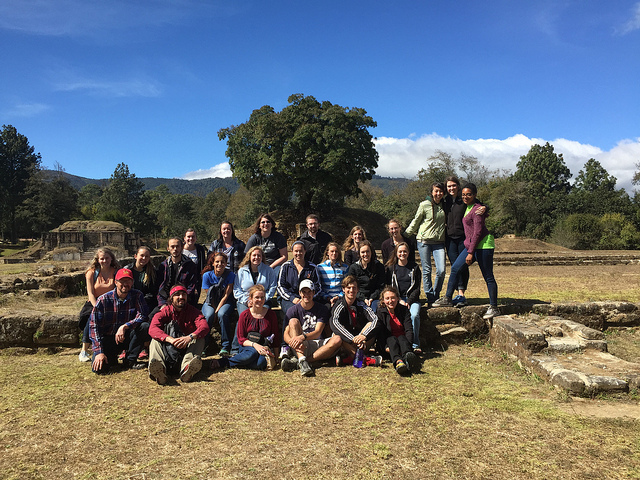17 February 2015
From the images of the suffering Christ visible on the walls of ancient cathedrals, to the presence of wooden crosses hanging above front doors, it is evident that religion is a large part of culture here in Guatemala. This past week, the visits and discussions have centered around religious expression present throughout the country. On Tuesday, Fabian Cabezos, a Bible professor here at Semilla, spoke about the Neo-Pentecostal movement in Guatemala and discussed the main characteristics that differentiate Neo-Pentecostal churches from others, specifically Pentecostal churches. Later in the week, we had the opportunity to visit a well-known mega church, Casa de Dios. We received a tour of the facilities and learned that it houses around 12,000 people, with 2 services every Sunday. On Friday, Rafael Escobar, dean of the seminary at Semilla, discussed the history of Mennonites in Guatemala. The presentation was intriguing, as many of us learned that the church was founded on Dispensationalism and some Mennonite churches continue to practice it today. The majority of the group attended the morning service at Casa de Dios, along with thousands of others. Several students also attended Casa Horeb, a small Mennonite church in the city. This past week was full of new information and experiences that will hopefully continue to help us gain a better understanding of the lives of those around us.
-Molly White & Kenzie Lapp
To have an opinion about a church is not an easy thing to do, especially when it is a church as big as Casa de Dios. The church is huge. While the designer said it was made to feel small, I wonder if her definition of small and mine are different. Sunday’s service was an interesting experience. The music reminded me of a Christian rock concert I went to once. It was a fun mix of fast and slow songs. The pastor’s wife also led a prayer and told us about providing for the church through the message of a passage in I Timothy.
The main focus of the service was a comical version of Romeo and Juliet or in Spanish Romeo y Julieta. It was really funny, at least the parts that I understood. I am not sure what Romeo and Juliet has to do with God but it was a well-executed performance.
Compared to the other two churches I have been to here, it has its’ own unique style. It is almost nothing like the Catholic Church, with the Mayan flavoring, we went to in ChiChi. While that one seemed very solemn and ritual based, this one was upbeat and lively. The music was similar to the Pentecostal church my host family goes to. There also seemed to be a sense of emotional release shared between the two. However, neither of the others would have performed a comical Romeo and Juilet for the main part of the service.
In total I feel like there must be something people like about this church and God must be present somehow. Personally I don’t feel like I would get much out of such a large church. To me church is about community as much as it is about God. I just don’t see how community is possible in a church that large.
–Molly White
“We evolve into the images we carry in our minds. We become what we see.” -Henri Nouwen
My time here in Guatemala has been filled with sights & sounds that have provoked countless questions and exposed me to ways of life previously unimagined. From the abundance of candles and the aroma of burning incense at mass in Chichicastenango, to the flashing lights accompanied by bass guitars resounding in the auditorium of Casa de Dios, contrast has been an ever-present theme pressing on my mind. I find it difficult to refrain from comparing what I am experiencing to the images I carry in my mind of life in the U.S. An even greater challenge has been trying to consciously push thoughts of “Well, in the U.S…” aside while trying to fully experience things as they are. Images I carry in my mind, as well as numerous advertisements lining the busy streets of Guatemala referencing Western lifestyles, are constant reminders of the unfamiliarity I am experiencing, as well as the familiarity I long for. By resisting the natural urge to categorize and compare solely based on previous knowledge, it is my hope that I will be able to fully experience Guatemala with an open mind and a willingness to learn.
While this would be the ideal way in which I would continue my time here in Guatemala, I realize that the images I carry in my mind are there to stay. I have come to understand that talking with others about contrasting ways of life is a healthy part of processing my experiences in Guatemala. At first, I wanted to build off of a blank slate, but I quickly discovered this was an unattainable feat.
Synthesizing is defined as combining many things to create something more complex, and this process has been important for me to keep in mind. Instead of desperately searching for familiarity and simplicity, I am slowly learning that it is through attempting & encouraging, asking & observing, and finally, listening & receiving that I am able to combine my own images with those around me to create a powerful complexity that remains open to exploration.
-Kenzie Lapp

